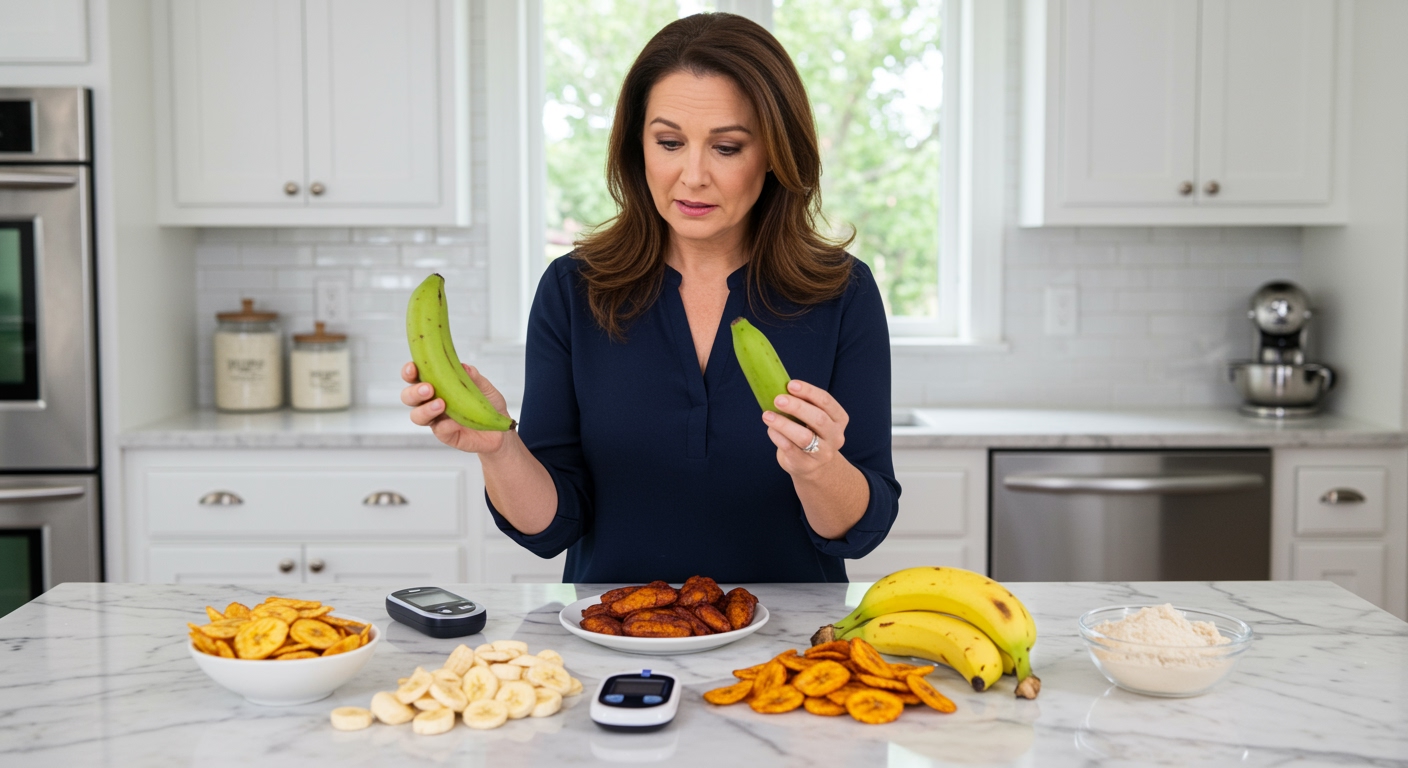✪ Key Takeaway: Green plantains are safer for diabetes than ripe ones due to lower sugar content and higher resistant starch levels.
Introduction
You walk through the grocery store and spot those large, banana-like fruits hanging in the produce section.
Your mind races with questions about whether plantains will spike your blood sugar or if they can fit into your diabetes meal plan.
Hi, I’m Abdur, your nutrition coach and today I’m going to explain exactly how plantains affect your blood sugar and which types are safest for diabetes management.
How Do Plantains Affect Blood Sugar Levels?
Plantains impact your blood sugar differently depending on their ripeness level and preparation method.
Green plantains contain high amounts of resistant starch, which your body cannot easily digest.
This resistant starch acts like fiber in your digestive system, slowing down sugar absorption and preventing rapid blood glucose spikes.
Research shows that green plantains have a glycemic index of around 40, which falls into the low category.
As plantains ripen and turn yellow or black, their starch converts to simple sugars like glucose and fructose.
Ripe plantains can have a glycemic index reaching 70 or higher, putting them in the high glycemic category that causes rapid blood sugar increases.
✪ Fact: Green plantains contain up to 80% resistant starch, while ripe plantains contain less than 5%.
Which Type Of Plantain Is Best For Diabetes?
Green plantains are your safest choice when managing diabetes.
Their firm texture and starchy composition make them behave more like a vegetable than a fruit in your body.
Studies demonstrate that consuming green plantains can actually improve insulin sensitivity over time.
The resistant starch in green plantains feeds beneficial bacteria in your gut, producing short-chain fatty acids that help regulate blood sugar.
Yellow plantains fall somewhere in the middle, with moderate sugar content and glycemic impact.
Black or very ripe plantains should be treated like dessert – they contain the highest sugar levels and will cause the most significant blood glucose rises.
If you choose to eat ripe plantains, limit your portion to a small slice and pair it with protein or healthy fats to slow absorption.
✪ Pro Tip: Choose plantains that are completely green with no yellow spots for the lowest blood sugar impact.
How Should You Prepare Plantains For Diabetes?
Your cooking method dramatically affects how plantains impact your blood sugar levels.
Boiling or steaming green plantains preserves their resistant starch content and keeps the glycemic index low.
These gentle cooking methods break down the tough fibers without converting starches to simple sugars.
Frying plantains, especially in oil at high temperatures, can increase their glycemic response and add unnecessary calories.
Baking green plantains at moderate temperatures maintains most of their beneficial properties while creating a satisfying texture.
You can slice green plantains thin and bake them into chips, or cut them into chunks and roast them as a potato substitute.
Adding spices like cinnamon, turmeric, or garlic not only enhances flavor but may provide additional blood sugar benefits.
✪ Note: Cooling cooked plantains increases their resistant starch content through a process called retrogradation.
What Is The Right Portion Size For Diabetics?
Portion control remains crucial even with diabetes-friendly green plantains.
A safe serving size equals about one-third of a medium green plantain, which provides approximately 15 grams of carbohydrates.
This amount fits into most diabetes meal plans as one carbohydrate exchange or serving.
Monitor your individual blood sugar response by testing before and two hours after eating plantains.
Some people with diabetes can tolerate larger portions of green plantains without significant glucose spikes.
Others may need to stick to smaller amounts or eat plantains only occasionally.
Pairing your plantain portion with lean protein, healthy fats, or non-starchy vegetables helps stabilize blood sugar further.
✪ Pro Tip: Start with a small portion and gradually increase based on your blood sugar readings and tolerance.
The Bottom Line
Green plantains can be a nutritious addition to your diabetes meal plan when eaten in appropriate portions and prepared properly.
Smart food choices are not about elimination but about understanding how different foods affect your unique body.
I would love to hear about your experiences with plantains or any questions you have about managing blood sugar with different foods – please share your thoughts in the comments below.
References
At NutritionCrown, we use quality and credible sources to ensure our content is accurate and trustworthy. Below are the sources referenced in creating this article:





